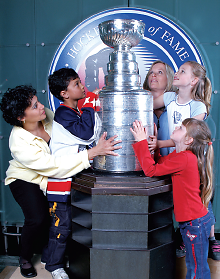“He shoots, he scores!”
Many an attendee at this year’s annual meeting may hear that phrase—first coined by Canadian broadcaster Foster Hewitt decades ago—numerous times during their stay, as televisions and mobile devices will be tuned to the National Hockey League (NHL) playoffs, which will be in full swing during the conference.
And even if Toronto’s own Maple Leafs will not be in action, the passion and excitement in the city will be evident. For while the popularity of ice hockey is growing globally—over the past few years countries including Qatar, Oman, and Jamaica have become members of the International Ice Hockey Federation (IIHF)—the sport’s heart remains in Canada.
Ask any Canadian about the 1972 Summit Series against the Soviets or the day in 1988 when Wayne Gretzky was traded from Edmonton to Los Angeles, or when the Canadian national team ended 50 years of futility by capturing the gold medal at the 2002 Winter Olympics, and they will probably remember the events as clear as yesterday.
As Neil Earle wrote in a 1995 article on popular culture for the Journal of Canadian Studies, “If hockey is just a game in Canada, then the Rockies are just hills on the prairie.”
For anyone who wants to learn more about this “game,” Toronto offers the perfect venue in the Hockey Hall of Fame, situated in a historic former bank building—one of the few in the district that survived Toronto’s Great Fire of 1904—at the corner of Front and Yonge streets.
Inside, the Hockey Hall of Fame covers over 60,000 square feet and features 15 exhibit areas dedicated to the history of the sport and its legends. Visitors can view all manner of uniforms, trophies, and other memorabilia, with the grand centerpiece being the Stanley Cup display in the Esso Great Hall, eloquently described as “a cathedral to the icons of hockey.”
Surrounded by the portraits and biographies of the Hall of Fame’s 381 “honoured members,” visitors can get up close and personal with the oldest trophy in North American sports, first awarded to the Montreal Hockey Club in 1893.
(Upon close inspection, one might notice that not every year has a champion; the Stanley Cup was not awarded in 1919 as the Spanish flu epidemic swept through and incapacitated most of the players from both teams before the deciding game, while in 2005 the playoffs never even started as the NHL was in the midst of a lockout.)
The remainder of the Hockey Hall of Fame should not disappoint adults and kids alike either. In addition to the varied static exhibits including an entire replica locker room, the Hall features interactive exhibits that let you take a slap shot or try and stop one as a goalie. Visitors can also try their hand at becoming the next Foster Hewitt in the TSN/RDS Broadcast Zone, which allows guests an opportunity to record their own broadcast from a library of classic hockey clips.
For the true enthusiast, the Hockey Hall of Fame also recently built the D.K. (Doc) Seaman Hockey Resource Centre, located in a separate building in Toronto’s Etobicoke neighborhood.
Inside the 18,000 square foot resource center one can become immersed in the Hall’s vast archival collections, which in addition to classic artifacts such as hockey books, programs, photos, and film reels, holds the largest hockey-stick storage facility in the world, capable of housing up to 4,000 hockey sticks at one time. ■
The Hockey Hall of Fame is located at 30 Yonge Street. More information, including hours, admission prices, and exhibit details, can be accessed
here.

